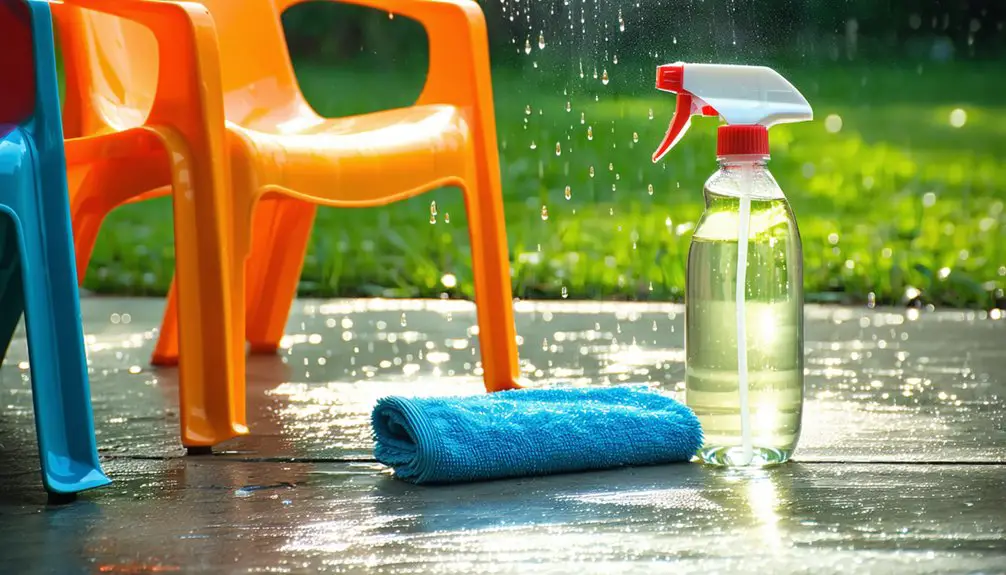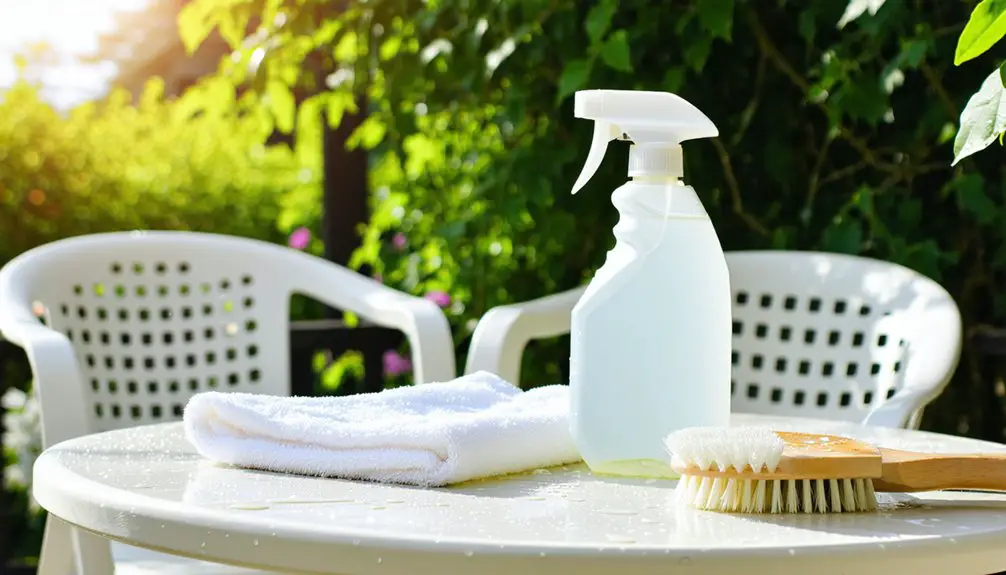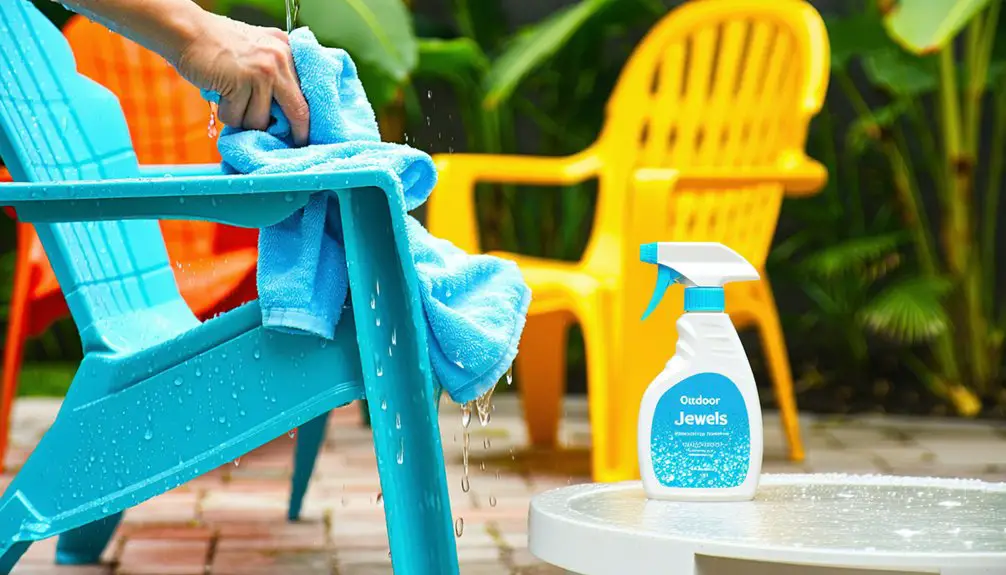A daily cleaning routine for your plastic furniture is essential to maintain its appearance and longevity. Start by using a damp microfiber cloth and a mixture of lukewarm water with dish soap to wipe down surfaces. For tougher stains, try equal parts of white vinegar and water. Rinse with a garden hose if needed. Don't forget to spot check any strong solutions on hidden areas first. Lastly, consider using furniture covers during extreme weather to protect your pieces. Want to know more tips on how to keep your furniture pristine and extend its lifespan?
Key Takeaways
- Wipe down plastic furniture daily with a damp microfiber cloth to remove surface dirt and prevent buildup.
- Use a mild soap and water solution for gentle cleaning, ensuring it maintains the furniture's appearance.
- Apply a vinegar and water mix to tackle any stubborn stains effectively during your cleaning routine.
- Rinse thoroughly with a garden hose to remove any soap residue after cleaning.
- Consider using UV protectors to prevent fading and maintain the integrity of your plastic furniture.
Importance of Regular Cleaning
Keeping your plastic furniture clean is essential for a variety of reasons. Regular cleaning prevents debris and dirt from building up, which can lead to stubborn stains over time. By doing simple daily wipe-downs with a soft cloth or brush, you not only maintain the appearance of your furniture but also protect its surface integrity. This routine minimizes the need for deep cleaning sessions, saving you time and effort. Additionally, using patio furniture covers can provide an extra layer of protection against dirt accumulation and harsh weather. Furthermore, incorporating UV protectors into your cleaning routine can help prevent fading and damage from sunlight.
Moreover, maintaining a regular cleaning schedule safeguards your furniture from extreme weather conditions. It helps avoid exposure to direct sunlight, which can cause fading or brittleness. During winter, storing your furniture indoors prevents cold damage, extending its lifespan significantly.
Beyond functionality, regular cleaning enhances the aesthetic appeal of your furniture. It keeps the original color intact and prevents discoloration or the chalky appearance due to oxidation. Utilizing plastic rejuvenators can further restore your furniture's brilliance.
Recommended Cleaning Solutions
When it comes to cleaning plastic furniture, selecting the right cleaning solutions is crucial for maintaining its appearance and longevity. Here are some recommended cleaning solutions that can help you tackle dirt and stains effectively:
- Soap and Water: Mix lukewarm water with a few drops of dishwashing liquid for a gentle clean.
- White Vinegar: Combine equal parts white distilled vinegar and water to tackle stubborn stains.
- Baking Soda Solution: Mix a quarter cup of baking soda with a quart of warm water for scrubbing stained areas.
- Essential Oils and Soapy Water: Add a few drops of essential oils like lemon or lavender to warm, soapy water for a refreshing clean.
- Bleach Solution: For tougher stains, mix 1/4 cup of bleach with a bucket of warm water. Bright colors attract stains more easily, so be extra cautious when cleaning furniture in vibrant hues.
Using these solutions can help you maintain your plastic furniture's look while ensuring its durability.
Always remember to spot-test any solution on a hidden area first and follow up with a thorough rinse, especially when using stronger chemicals like bleach.
Happy cleaning!
Effective Cleaning Tools

Cleaning plastic furniture effectively requires the right tools to ensure a thorough job without damaging the surface. Start with a damp microfiber cloth to wipe away surface dirt. If your furniture is particularly dirty, a garden hose works well for a more thorough rinse. For basic cleaning, you can also use paper towels or cloths dipped in water. Microfiber cloths are great for drying and providing a polished finish.
For tougher stains, consider using melamine foam sponges, like Mr. Clean Magic Erasers. These gentle abrasives become porous when wet, helping to polish out stains without damaging the finish. Just dampen the sponge before scrubbing and use it cautiously, especially on darker plastics. Additionally, regular cleaning helps prevent the buildup of dirt and grime, making future maintenance easier.
Baking soda is another effective tool for stubborn stains and odors. Create a paste with water and apply it to tough spots. Remember to rinse thoroughly afterward.
Soft-bristled brushes and sponges are essential for careful scrubbing without scratching the surface. Use them with mild cleaning solutions like white vinegar or dish soap to ensure your furniture stays looking its best.
Specialized Stain Removal Techniques
Stains on plastic furniture can be frustrating, but specialized techniques can make removal easier and more effective. Here are some methods to tackle those stubborn stains:
- Bleach Solution: Mix 1/4 cup of bleach with a gallon of warm water. Wear protective rubber gloves, then scrub gently with a brush. Let it sit briefly before rinsing thoroughly with a hose.
- Vinegar Mix: Combine equal parts of white vinegar and water. Apply to mildewed areas and let it sit for 10-15 minutes. Scrub gently and rinse well.
- Baking Soda Paste: Mix baking soda with a small amount of water to form a paste. Apply it to stained areas and let it rest for 15 minutes before gently scrubbing and rinsing.
- Oxygen Bleach: Follow the package instructions to mix oxygen bleach with warm water. Apply to discolored areas, let it sit for 15-30 minutes, then scrub lightly and rinse thoroughly.
- Spot Testing: Always spot test any solution on an inconspicuous area to ensure it's safe for your plastic furniture. Regular cleaning helps prolong the lifespan of plastic furniture while maintaining its appearance.
Using these techniques will help keep your plastic furniture looking clean and fresh!
Protective Measures for Longevity

Protecting your plastic furniture from environmental elements is crucial for its longevity. Start by covering your furniture or moving it indoors during extreme weather conditions. This simple step prevents damage from harsh elements like rain, snow, or intense sunlight.
To combat UV rays that can cause fading, consider applying UV-resistant coatings or sprays. Choosing high-quality materials will also enhance the durability of your furniture against these harmful effects.
During winter or extended periods of non-use, store your plastic furniture in a dry, sheltered area to avoid cracking or brittleness. When it's not in use, use furniture covers to shield against dust, pollen, and moisture.
Also, be mindful of hot objects; always use coasters or protective items to prevent heat damage to surfaces.
Regularly inspect your furniture for cracks or damage, and address any issues promptly to prevent further deterioration. Reinforce any weak joints to maintain structural integrity, and keep the furniture away from damp areas to prevent mold and mildew.
Lastly, avoid using harsh chemicals or abrasive cleaners, as these can damage the plastic surface. By taking these protective measures, you'll ensure your plastic furniture remains durable and aesthetically pleasing for years to come.
Frequently Asked Questions
Can I Use Vinegar on Colored Plastic Furniture?
You shouldn't use vinegar on colored plastic furniture. It can cause fading and deterioration. Instead, opt for a diluted dishwashing detergent solution to safely clean while preserving the color and integrity of your furniture.
How Can I Prevent Scratches on My Plastic Furniture?
To prevent scratches on your plastic furniture, use mild detergents and soft cloths for cleaning. Always place coasters under hot items and opt for felt protectors on legs to minimize contact and potential damage.
Is It Safe to Use a Pressure Washer on Plastic?
It's not safe to use a pressure washer on plastic. The high pressure can damage the surface, causing cracks and discoloration. Instead, opt for mild detergents and soft cloths to clean your plastic furniture safely.
What Should I Do if My Plastic Furniture Becomes Discolored?
If your plastic furniture becomes discolored, check for sunlight exposure or dirt buildup. Clean gently with a damp cloth and mild soap, then consider using baking soda or vinegar for stubborn stains to restore its appearance.
How Can I Tell if My Furniture Needs Cleaning?
You can tell your furniture needs cleaning by checking for visible dirt, stains, or discoloration. If it looks dull or has accumulated grime, it's time to grab your cleaning supplies and refresh it.

